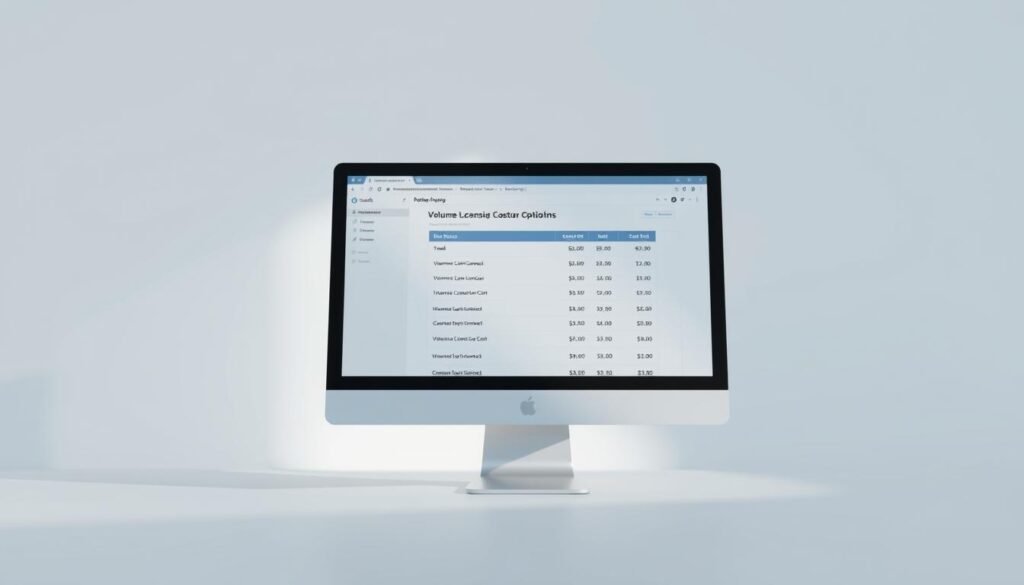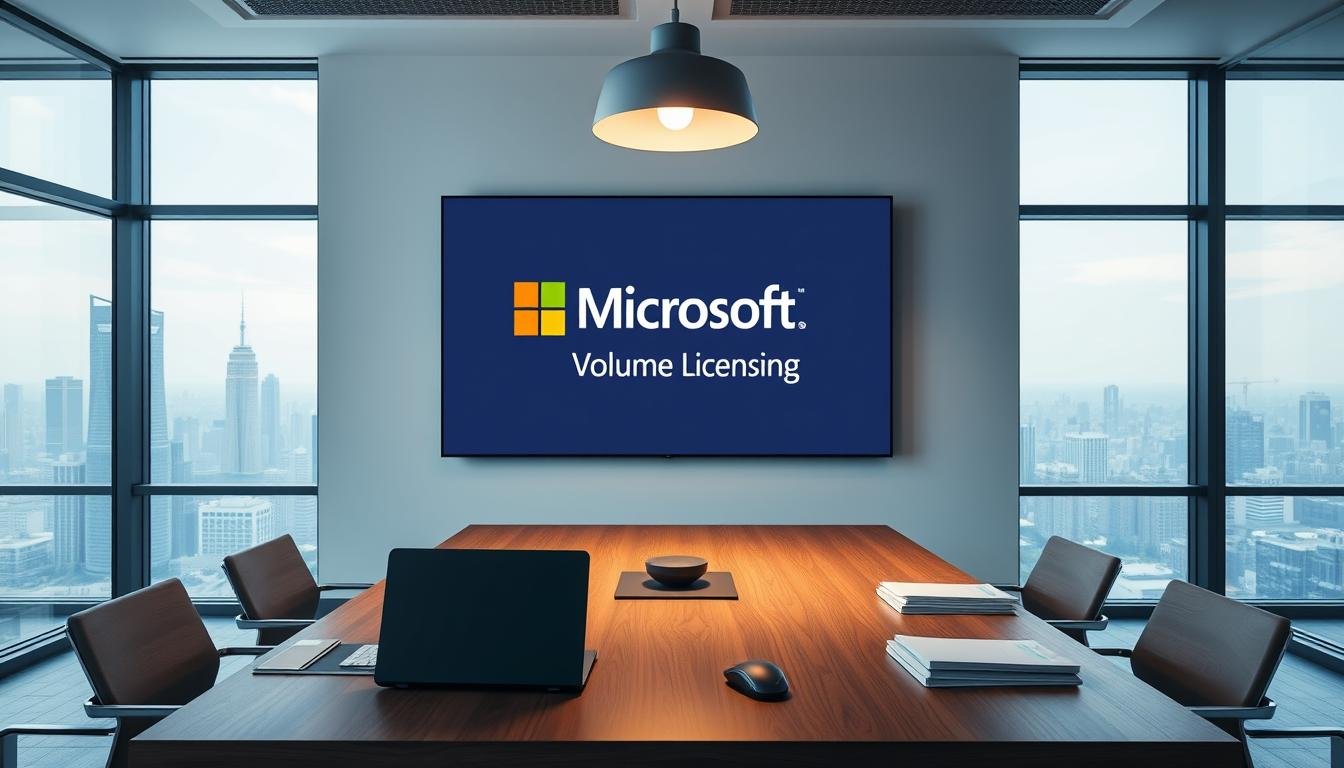Managing Microsoft software is key for companies. Microsoft Volume Licensing makes this easier.
Microsoft Volume Licensing helps companies buy many licenses at once. It means no need for extra software or papers with each license. This makes managing software simpler.
Knowing about Windows Volume Licensing helps companies save money. It also makes managing software more efficient.
Key Takeaways
- Simplified software management through Microsoft Volume Licensing
- Cost reduction by eliminating the need for multiple licenses
- Efficient management of Microsoft software
- Streamlined processes for organizations
- Understanding the benefits of Windows Volume Licensing
What is Windows Volume Licensing?
For organizations with many Microsoft software licenses, Windows Volume Licensing is a great choice. It’s both flexible and cost-effective. Microsoft looks at three things before selling Volume Licensing: the organization’s size and type, the software products, and how they will be used.
Definition and Overview
Windows Volume Licensing helps organizations manage their Microsoft software licenses easily. It lets them buy many licenses at once without needing separate media or documents. This makes it simpler to keep IT platforms consistent.
Key Features
The main features of Windows Volume Licensing are flexible licensing models and simplified license management. This program makes it easier for organizations to handle their licenses. It cuts down on the work needed for managing licenses.
- Flexible licensing models that fit different organizational needs
- Simplified license management to lessen administrative tasks
- The ability to buy many licenses at once, making the buying process smoother
Benefits of Volume Licensing
The advantages of Windows Volume Licensing include lower costs, simplified license management, and the chance to standardize IT platforms. Using volume licensing helps organizations manage their software better and save money.
Knowing the benefits and features of Windows Volume Licensing helps organizations make smart choices about their Microsoft software licensing.
Types of Windows Volume Licensing Programs
The world of Windows Volume Licensing offers many programs. They are made for different sizes and needs of organizations.
Open License Program
The Open License Program is great for small to medium-sized businesses. It’s perfect for companies with less than 250 devices or users. This makes it a good choice for businesses that are growing.
Enterprise Agreement
For larger organizations with 250 or more users/devices, the Enterprise Agreement is better. It offers a full licensing solution. This includes software assurance, making it easier to keep your Microsoft products up to date.
Microsoft Products and Services Agreement (MPSA)
The MPSA is another flexible option. It lets organizations buy a wide range of Microsoft products and services. It’s a simplified and cost-effective way to handle your Microsoft licensing.
To understand the differences, here’s a comparison table:
| Licensing Program | Ideal For | Key Features |
|---|---|---|
| Open License Program | Small to medium-sized businesses ( | Flexible licensing, easy to manage |
| Enterprise Agreement | Large organizations (250+ devices/users) | Comprehensive licensing, software assurance |
| MPSA | Organizations seeking flexibility | Simplified licensing, cost-effective |
Knowing about the different Windows Volume Licensing programs helps organizations make smart choices. They can find what fits their needs and budget.
How to Choose the Right Licensing Option
Choosing the right Volume Licensing program is a big decision. You need to think about your organization’s size, software needs, and budget. It’s important to know the different licensing options and how they fit your needs.
Assessing Your Organization’s Needs
The first step is to look at your current software setup and plans for the future. You need to figure out how many users and devices you have. Knowing your volume licensing requirements is key.
When looking at your needs, consider these points:
- Number of users and devices
- Type of software needed (like Windows or Office)
- Current software setup
- Plans for growth
Considering Software Deployment
How you plan to deploy software is also important. If you have complex plans or big upgrades, look for licensing that’s flexible and can grow with you.

Budget Considerations
The cost of Volume Licensing is a big factor. Prices depend on your organization’s size, number of licenses, type of license, and Software Assurance. It’s important to plan a budget that includes these costs.
| Licensing Factor | Description | Impact on Cost |
|---|---|---|
| Organization Size | Larger organizations get better prices because of economies of scale. | More licenses = lower cost per license |
| Number of Licenses | The total number of licenses you need. | More licenses = lower rates |
| License Type | There are different types of licenses (like user-based or device-based). | Costs vary by type |
| Software Assurance | This service gives access to new versions, support, and training. | Increases cost but offers big benefits |
By looking at these factors and understanding the costs, you can make a smart choice. This ensures you pick the best and most affordable licensing option for your organization.
Steps to Acquire Windows Volume Licensing
Organizations looking to get Windows Volume Licensing need to follow a few key steps. The process is made simple to help companies get the licenses they need for Windows.
Initial Contact with a Microsoft Partner
The first step is to reach out to a Microsoft partner. These partners are approved by Microsoft to sell and support volume licensing deals. They help guide companies through the licensing process, helping them pick the right option.
Working with a Microsoft partner gives companies advice that fits their needs. This first step is important for a successful licensing deal.
Evaluation of Licensing Types
After contacting a Microsoft partner, companies need to look at the different licensing options. They should understand Open License, Enterprise Agreement, and Microsoft Products and Services Agreement (MPSA). Each has its own benefits and fits different needs.
Choosing the right licensing type is key. Companies should think about their user numbers, software plans, and budget. This helps pick the best option.
| Licensing Type | Description | Best For |
|---|---|---|
| Open License | A simple agreement for small to medium-sized businesses. | Small to medium-sized businesses. |
| Enterprise Agreement | Offers flexibility and savings for big organizations. | Large organizations with complex needs. |
| MPSA | Flexible for buying various Microsoft products and services. | Organizations wanting flexibility. |
Completing Purchase and Agreements
After picking the right licensing, the next step is to buy and sign the agreements. Companies work with the Microsoft partner to make sure everything is done right. They also need to understand their agreement.
“The key to a successful volume licensing agreement is not just in the initial purchase, but in ongoing management and compliance.” – Microsoft Licensing Expert
Buying and signing the agreements is the last step. Companies should then set up a system to manage their licenses well.
Installing Windows with Volume Licensing
Volume Licensing for Windows needs a good grasp of the activation process. This ensures both compliance and functionality. Organizations can activate Windows using a Key Management Service (KMS) or a Multiple Activation Key (MAK).
Activation Process
The activation process is key to making sure Windows installations are genuine. KMS is best for big organizations. It lets them activate Windows on their network, without needing each computer to call Microsoft.
KMS activation means setting up a KMS host in the organization’s network. This host then activates Windows on all connected computers. It’s great for big groups with lots of Windows installations.
MAK is for activating Windows on computers that don’t often connect to the company network. MAK activation can be done online or by phone. It’s easy for smaller groups or those with computers that rarely connect to the company network.
Troubleshooting Common Issues
Even though KMS and MAK activations are simple, problems can happen. Common issues include activation failures because of wrong setup or network problems. To fix these, make sure your KMS host is set up right and your network lets computers talk to the KMS host.
- Make sure your KMS host is activated and set up right.
- Check that your network lets computers talk to the KMS host.
- For MAK activations, enter the MAK key correctly and make sure computers can reach Microsoft’s servers.
Knowing how to activate Windows and how to solve common problems helps organizations manage their Windows Volume Licensing well. This ensures they follow Microsoft’s licensing rules.
Managing Volume Licenses
Managing Volume Licenses is key for companies to follow rules and get the most from Microsoft. It involves several important steps to keep track of software. This helps companies use their licenses wisely.
Tracking and Reporting
Tracking and reporting license use is a big part of managing Volume Licenses. The Volume Licensing Service Center (VLSC) is a great online tool for this. It lets companies manage their Microsoft Volume Licensing agreements well. With the VLSC, companies can:
- Track license usage and downloads
- View product keys and licenses
- Access detailed reporting on their licensing agreements
Using the VLSC helps companies understand their license status. This helps them plan for future software needs.
Renewal Procedures
Renewing Volume Licensing agreements is also very important. Companies need to know when to renew to keep coverage and follow rules. The VLSC helps with this by:
- Providing notifications for upcoming renewals
- Offering guidance on the renewal process
- Allowing organizations to review and update their licensing agreements as needed
Renewing licenses on time keeps services running smoothly and follows Microsoft’s rules.
Compliance Best Practices
Staying compliant is essential for Volume Licensing management. Companies should follow best practices like:
- Regularly reviewing license usage against deployed software
- Conducting internal audits to ensure compliance
- Utilizing tools like the VLSC to monitor and manage licenses
By following these steps, companies can avoid non-compliance issues and penalties.
In summary, managing Volume Licenses well means tracking, timely renewals, and following compliance rules. Using tools like the VLSC helps companies manage these tasks. This ensures they get the most from Microsoft while staying compliant.
Budgeting for Windows Volume Licensing
Effective budgeting for Windows Volume Licensing means knowing the costs and options. Organizations need to think about their budget when choosing a Volume Licensing program. This way, they can get the most value from their investment.
Understanding Licensing Costs
Licensing costs depend on several things. These include the size of the organization, how many licenses are needed, and the type of licenses. It’s important to look at these factors to figure out the total cost.
The costs of Windows Volume Licensing include the initial cost of buying licenses. There are also costs for upgrading to new Windows versions and for renewing licenses over time. Careful planning is key to managing these expenses well.
| Cost Component | Description | Factors Influencing Cost |
|---|---|---|
| Initial Costs | Costs associated with purchasing licenses | Number of licenses, License type |
| Upgrade Costs | Costs for upgrading to new Windows versions | Frequency of upgrades, Number of licenses |
| Renewal Costs | Costs for renewing licenses | Renewal frequency, Number of licenses |
Budgeting for Upgrades and Renewals
To budget well for upgrades and renewals, first know your current licensing agreement. Proactive planning helps avoid unexpected costs.
Organizations should check their licensing needs often and adjust their budget as needed. This includes thinking about future growth or changes in licensing needs.
Understanding Windows Volume Licensing costs and planning for upgrades and renewals helps organizations make the most of their licensing investment.
Security and Support Concerns
Windows Volume Licensing users face unique security and support challenges. These must be addressed to ensure a secure and efficient operating environment. One of the primary volume licensing benefits is the ability to maintain a secure system through regular updates and robust support services.
Regular Security Updates and Patches
Microsoft provides regular security updates and patches for Volume Licensing customers. These updates help protect against vulnerabilities and maintain system integrity. They are key for safeguarding against emerging threats and ensuring compliance with security standards.
To make the most of these updates, organizations should have a strong update management process. This includes testing updates in a controlled environment before deployment. It also ensures that all systems are up-to-date.
Utilizing Microsoft Support Services
Microsoft support services are a valuable resource for organizations using Windows Volume Licensing. These services offer help with licensing queries, technical issues, and other concerns. They help minimize downtime and resolve problems efficiently.
- Access to a dedicated support team for personalized assistance
- Comprehensive support resources, including online documentation and community forums
- Priority support for critical issues, ensuring timely resolution
By using these support services, organizations can improve their experience with Windows Volume Licensing. They ensure they get the help they need when they need it.
Common Misconceptions About Volume Licensing
Many organizations have wrong ideas about Volume Licensing. This can affect their choices. It’s key to know the truth about Volume Licensing to make good decisions.
Debunking Myths
Some think Volume Licensing is too hard to handle. But, with the right help, it’s easy. Microsoft’s Volume Licensing programs are made to fit different sizes and types of organizations.
Another wrong idea is that it’s only for big companies. But, Volume Licensing agreements help all kinds of organizations. They offer good prices and make managing software easier.
| Myth | Reality |
|---|---|
| Volume Licensing is too complex. | With proper guidance, it’s manageable. |
| Only for large enterprises. | Beneficial for organizations of all sizes. |
| Expensive upfront costs. | Can be cost-effective in the long run. |
Clarifying Licensing Confusion
People often get confused about volume licensing requirements. It’s important to know what software you need to pick the right license.
Also, Volume Licensing agreements aren’t the same for everyone. Microsoft has different programs, like the Open License Program and Enterprise Agreement. Each is made for different needs.

By understanding Volume Licensing and clearing up myths, organizations can make better choices. This can save money and make managing software easier.
Resources for Further Learning
Organizations using Windows Volume Licensing can find more resources to help them. These resources can improve their understanding and management of licensing agreements. This can lead to better compliance and cost savings.
Microsoft Licensing Guide
Microsoft has a detailed licensing guide for volume licensing. It’s a key resource for understanding licensing programs. You’ll find information on the Open License Program and Enterprise Agreement.
Online Forums and Communities
Online forums and communities about Microsoft volume licensing are great. They offer insights and advice. You can share your experiences and learn from others.
Consulting with Experts
Getting advice from experts in Microsoft volume licensing is helpful. They can give you specific advice on managing licenses. They can also help with compliance and cost optimization.

